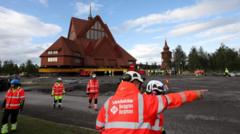The community of Kiruna, a small city in northern Sweden, is witnessing a remarkable undertaking as its landmark Kiruna Church, a stunning structure standing for over a century, embarks on a two-day journey to a new location. The church, built in 1912, is being slowly relocated along a 5-kilometer route to evade threats posed by ground subsidence caused by decades of iron ore mining.
The enormous red timber church, which measures 35 meters high, 40 meters wide, and weighs an impressive 672 tonnes, is being raised on specially designed rolling platforms and moved at a cautious pace of up to 500 meters per hour. This ambitious project signifies a deeper effort to relocate various buildings in response to geological hazards threatening the old city center. “It’s like finally, let’s get it done. We’ve been waiting for so many years,” expressed culture strategist Sofia Lagerlöf Määttä, reflecting the shared urgency of the community.
Multiple other structures within Kiruna, facing similar threats, have already been shifted or demolished as local authorities prepare for the ongoing consequences of mining activities. The church's move stands as the most prominent in this effort, drawing attention to the broader challenges faced by Kiruna residents as their home adapts to the realities enforced by industry.
“Under Swedish law, mining cannot occur under existing buildings, which makes it crucial to act before infrastructure fails,” remarked Robert Ylitalo, CEO of Kiruna's development company. The project's financial burden is being shouldered by LKAB, the operator of the iron ore mine, who will fund the estimated $1 billion cost of relocating the city.
Engineers have ensured that the church will move as one piece, with significant preparations made to widen roads and clear obstacles along the route. A notable focus has been the protection of the church's interior, which includes a cherished altar painting by Prince Eugen. “It’s an emotional moment for many, as the church has been a vital gathering place for our community for generations,” Määttä shared.
In light of this extraordinary endeavor, vicar Lena Tjärnberg expressed sentiments of loss as the church transitions from its longstanding home. “The church is leaving a place where it truly belongs,” she stated. Yet, there is hope as locals remember the cherished memories tied to the church while looking forward to new opportunities in their changing environment.
As the massive walls of the church move along the route, crowds, including the King of Sweden, are expected to gather, highlighting the profound importance of this event. It stands as a powerful reminder that despite the challenges presented by modernization, communities can adapt while holding onto their historical roots.
The enormous red timber church, which measures 35 meters high, 40 meters wide, and weighs an impressive 672 tonnes, is being raised on specially designed rolling platforms and moved at a cautious pace of up to 500 meters per hour. This ambitious project signifies a deeper effort to relocate various buildings in response to geological hazards threatening the old city center. “It’s like finally, let’s get it done. We’ve been waiting for so many years,” expressed culture strategist Sofia Lagerlöf Määttä, reflecting the shared urgency of the community.
Multiple other structures within Kiruna, facing similar threats, have already been shifted or demolished as local authorities prepare for the ongoing consequences of mining activities. The church's move stands as the most prominent in this effort, drawing attention to the broader challenges faced by Kiruna residents as their home adapts to the realities enforced by industry.
“Under Swedish law, mining cannot occur under existing buildings, which makes it crucial to act before infrastructure fails,” remarked Robert Ylitalo, CEO of Kiruna's development company. The project's financial burden is being shouldered by LKAB, the operator of the iron ore mine, who will fund the estimated $1 billion cost of relocating the city.
Engineers have ensured that the church will move as one piece, with significant preparations made to widen roads and clear obstacles along the route. A notable focus has been the protection of the church's interior, which includes a cherished altar painting by Prince Eugen. “It’s an emotional moment for many, as the church has been a vital gathering place for our community for generations,” Määttä shared.
In light of this extraordinary endeavor, vicar Lena Tjärnberg expressed sentiments of loss as the church transitions from its longstanding home. “The church is leaving a place where it truly belongs,” she stated. Yet, there is hope as locals remember the cherished memories tied to the church while looking forward to new opportunities in their changing environment.
As the massive walls of the church move along the route, crowds, including the King of Sweden, are expected to gather, highlighting the profound importance of this event. It stands as a powerful reminder that despite the challenges presented by modernization, communities can adapt while holding onto their historical roots.






















